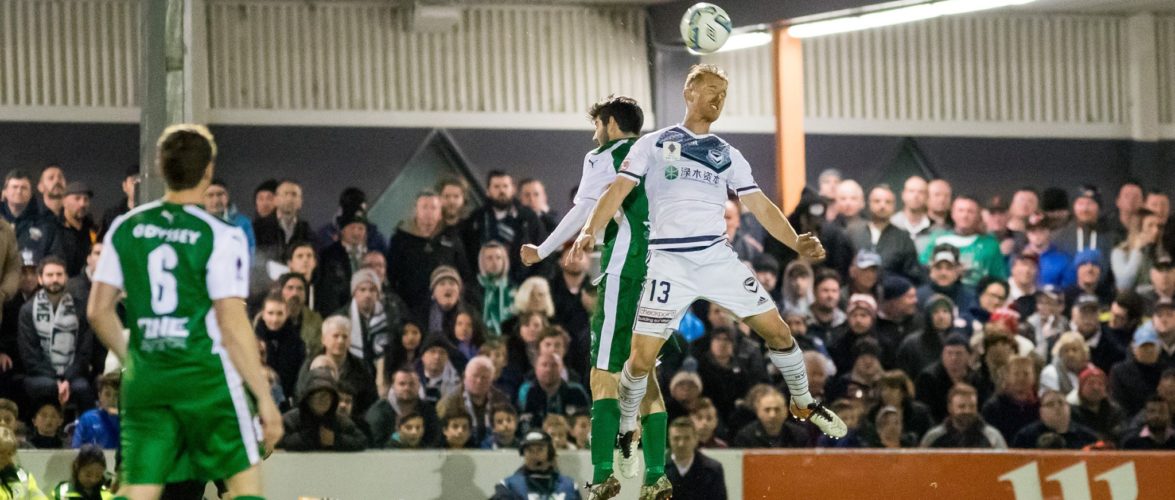Image: Anita Milas
The FFA Cup markets itself on the possibility of astonishment. Unpredictability is the clear drawcard of a fledgling competition that, in its infancy, has experienced its own surprise – a level of public interest and backing few would have expected.
The cup is helping re-ignite public interest in Australian football’s old guard by allowing the thrust of yesteryear’s champions into the contemporary spotlight. The television exposure alone is momentous for NPL clubs. Furthermore, it preserves the national importance of old rivalries and generates new ones.
It is also the shining light illuminating the debate of promotion-relegation via the strength of the NPL and the capacity for a national second division.
Yet the narrative has the potential to become repetitive very quickly – a few NPL clubs (usually a select few stronger clubs from each state) may cause upsets early, before the quarter finals onwards lope to an anti-climactic conclusion with NPL clubs’ players and resources stretched by September while A-League clubs begin to peak.
So where to now for such a positive part of Australian football’s future journey? Well, some issues appear to still need ironing out. One pre-eminent question remains.
While the cup is continuing to grow year on year, does it really showcase the best of Australian semi-professional football? One has to wonder whether the format gives the long shot a fighting chance when disparity is seemingly sewn into the fabric of the contest.
Bentleigh Greens and Hume City’s defeats against Melbourne Victory in their quarter- and semi-finals respectively provides an example. Many in the media praised the NPL outfits’ structure and effort following the match-ups, highlighting their dogged determination. Dog-tired may have been a more apt description.
Little was said of the fact Bentleigh had played nearly 40 games since February this year. Even with Victory’s A-League, FFA Cup and Asian Champions League campaigns of last team, a semi-professional club nearly played the same amount of fixtures as their professional counterparts, but with a much smaller squad size – brought on in-part by NPL clubs needing their FFA Cup squads compliant to NPL rules – including abiding by the player points system and the two-foreigner rule (against the A-League’s five), and also and cup-tied rule (which mainly affects NPL clubs at this stage of the competition).
And, at this part of the year, Victory had no injury list having only been three competitive fixtures into their 2016-17 campaign. Bentleigh were missing their captain, Wayne Wallace and top scorer Chris Lucas, amongst others.
Many of the clubs involved in a deep cup run quickly learn it can become a poisoned chalice, physically, mentally and financially.
“We’ll sit down next year and work out in which competition we want to be successful,” John Anastasiadis remarked after the quarter-final, with no hint of cynicism. The veteran coach realises for semi-professional clubs expectations are defined often by necessity, rather than talent.
“Tt’s been a long season for us. It was tough to get up physically because a lot of the boys have little, niggling injuries. I think we also lost some key players during that time, and of course we can’t replace them.”
While priorities are a natural aspect of sport, there is a peculiar askew of preference emerging across the NPL. While league success should take obvious supremacy, the FFA Cup often defines an NPL club’s season and dictates the talk around whether a player or coach is A-League worthy.
And yet the issue for the NPL and more broadly Football Federation Australia is that member federation clubs are struggling to give a proper account of themselves at this stage of the season. The lack of synchronisation between A-League and NPL seasons is at the root of this inequality.
When questioned about what needs to change, Anastasiadis begins to sound exasperated. It could be expected from a man who, despite a valiant campaign, suffered three consecutive defeats to end his year.
“Can it change? Can the FFA Cup be brought forward a bit?” he says. “It gives (A-League sides) a bit of an unfair advantage at this stage, so I don’t think we’ll see an NPL FFA Cup champion anytime soon.”
Indeed, a 23-man roster of part timers can only be stretched so far. Having competed valiantly, Anastasiadis’ side were crowned NPL premiers and Dockerty Cup champions this season, as their clear superiority reigned in the NPL season proper. It is telling then, a weary and wounded Bentleigh would go on to crash out of the NPL and FFA Cup at the semi and quarter-final stage respectively, along with a first-up defeat in the national NPL finals series. Injuries, fatigue and wildly varying levels of fixture congestion finally took their toll on the Greens.
“You can’t, unfortunately, have 26 players on your books” Anastasiadis says. “You’re going to have six or 7 disappointed players every week and you can’t have that in your dressing room, because if you don’t play at this level, you don’t get paid.”
It is hard to pass off as coincidence that last season, when Bentleigh achieved the NPL championship after they had left the FFA Cup at the preliminary round – similarly, their semi-final run in 2014 coincided with a poor league campaign by their standards. Moreover, both of the contenders in 2016’s Victorian NPL grand final – South Melbourne and Oakleigh Cannons – made early exits from the FFA Cup this year. The difficulty in balancing many fronts is heightened at semi-professional level.
This is not to say the cup is a burden to bear on NPL sides. The fruits of their labour can be exceptionally bountiful. Reports that Bentleigh had to spend $60,000 on ground improvements in order to satisfy broadcast requirements for the Victory game at Kingston Heath, yet will still emerge financially the better off for their cup run, speak for themselves.
In addition, the FFA will point to the success of clubs like Canberra Olympic as examples of the lack of any obvious disparity. Anastasiadis certainly believes the gap is narrowing in terms of talent, which he believes is even more reason to address any persistent imbalances.
“I think in terms of quality (NPL sides) are not far off.” Anastasidais reflects. “In terms of infrastructure and wages I think Australia’s a bit behind. There’s quality knocking about in the state leagues, it’s just about giving those guys an equal go.”
Listening to NPL coaches, there exists a glowing reminder that their sides form the basis of the FFA Cup’s enduring success. With more equal conditions, it can only add to the magic of the cup.

